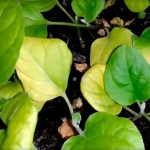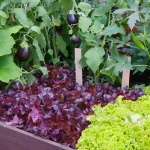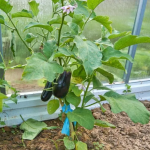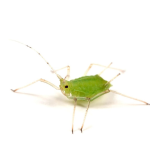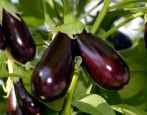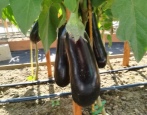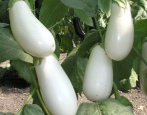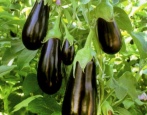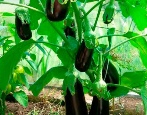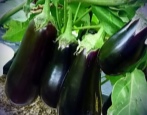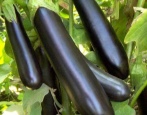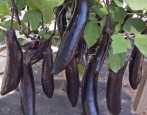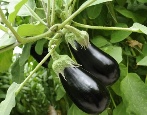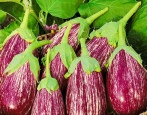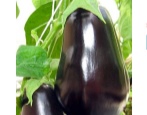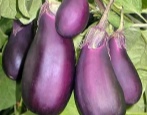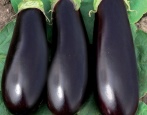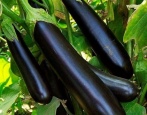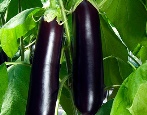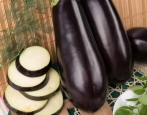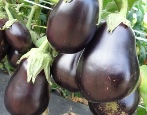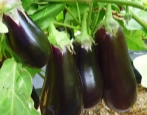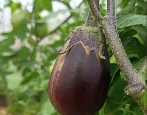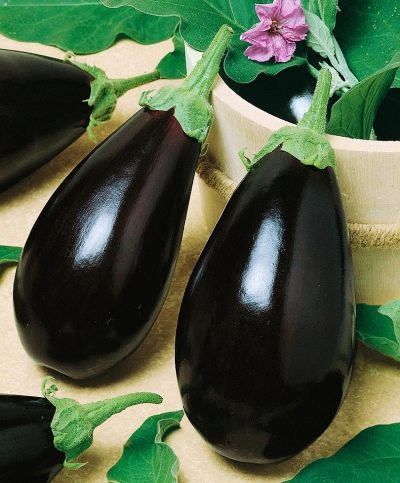
- Name synonyms: Galine
- Year of approval: 2003
- Growth type: medium-sized
- Bush height, cm: 70
- Fruit size: large
- Fruit shape: spherical
- Fruit weight, g: 200-500
- Yield: high yielding
- Keeping quality: good
- Transportability: good
For those who like to plant new eggplant varieties on the site every year, a hybrid of French selection with the beautiful name "Galine" will be a godsend. The crop is characterized by quick adaptation to the climate, good yield and excellent taste of the fruit. It will not be difficult to grow a vegetable if you familiarize yourself with the intricacies of cultivation and agricultural technology.
Breeding history
The Galine eggplant is a first generation hybrid bred by the French breeders of the Clause company in 2000. After 3 years (in 2003), the vegetable crop was added to the State Register of Admitted to Use. The vegetable is cultivated in different climatic zones of the country. It is recommended to grow eggplant both on garden ridges, and under film shelters, and in greenhouse structures.
Description of the variety
The Galine hybrid is a medium-sized bush that grows up to 60-70 cm.The plant is characterized by closeness of branches, abundant thickening of bright green foliage that protects against sunburn, powerful stems with anthocyanin color and moderate pubescence, as well as an average length of internodes, where it is laid on two inflorescences.
In addition, it is worth noting the developed root system, the presence of thorns on the calyxes, as well as the aesthetic appeal of the bushes during flowering. Plants bloom with pale lilac flowers. On a healthy eggplant bush, up to 13-15 identical specimens ripen. In some cases, up to 40 eggplants ripened per season.
Characteristics of the appearance of plants and fruits
Galine eggplant is a large-fruited variety. The vegetables are ripened even and flavorful. Often vegetables gain weight from 200 to 350 g, but sometimes the fruit grows up to 500 grams. A distinctive feature of the hybrid is the non-standard shape of the eggplant - spherical. The length of the vegetable reaches 15-18 cm, and the diameter is 7-9. An absolutely ripe specimen is endowed with a uniform brown-purple color. The surface of the eggplant is very smooth, shiny, without depressions or ribs.
Thanks to the thin, but sufficiently strong and elastic peel, the harvested eggplants can easily be transported over long distances, as well as stored for a long time without loss of taste and marketability - up to 4-5 weeks.
Purpose and taste
Galine is remembered not only for its attractive appearance, but also for its excellent taste. The pale greenish pulp is endowed with a moderately loose, delicate structure without voids, wateriness and fibrillation. The flesh of the vegetable is pleasant, oily, without pungency and bitterness. There are very few seeds in the vegetable, moreover, they are small.
The harvested crop can be used for cooking hot and cold dishes, pickled, frozen, baked, processed into caviar, and canned.
Ripening terms
This hybrid belongs to the mid-season varieties. Full ripening of fruits from mass germination occurs in 90-105 days. The growing season itself lasts only 60-65 days. Fruiting in a culture is quite long. You can harvest the crop for one and a half months - from mid-July to early September.
Yield
The yield indicator of the hybrid is excellent, which absolutely does not depend on the vagaries of the weather. On average, 4 kg of delicious vegetables can be removed from 1 m2 of plantings. In a greenhouse, you can count on 6-7 kg / m2.
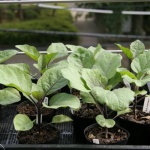
To get a tasty and bountiful eggplant crop, you must first grow strong and healthy seedlings.This culture is considered very capricious, therefore, you need to take care of seedlings when growing at home as correctly and carefully as possible.
Landing scheme
When planting a vegetable, it is important to take into account some of the nuances - planting density, as well as the distance between plantings. It is enough to plant 4-5 bushes per 1 m2. Planting should be carried out according to the scheme 60x35 cm.
Growing and care
When growing, preference is given to the seedling method. In late May - early June, matured bushes at the age of 60 days are transferred to a permanent place of growth. The best predecessors for this culture are legumes, carrots, greens.
Eggplant care includes:
- watering at the root with warm water;
- application of mineral and organic fertilizers (2-3 times per season);
- loosening and weeding the soil every 10 days4
- mulching row spacings with sawdust4
- garter bushes, removal of lateral processes and foliage to the first fork;
- prevention of diseases and insect infestations.

Planting eggplant is one of the most important stages in growing. When choosing a place for eggplants on your site, it is important to remember that this culture should be in warm soil, constantly illuminated by the sun. The plant is also very fond of spacious, open spaces, since its roots can grow over sufficient areas.
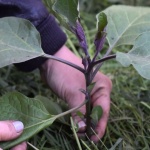

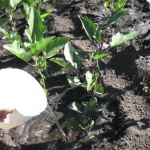
Soil requirements
The French hybrid, like most of its relatives, prefers light, fluffy, fertilized, moisture and air permeable soils. It is important that the acidity level of the soil is neutral or low.
Required climatic conditions
Vegetable crops have high stress resistance. Eggplant is resistant to sudden temperature changes, prolonged heat and short shade. At the same time, it is comfortable to grow a culture in sunny areas, where there is a lot of heat, light, good air circulation, and there is also a protective barrier against gusty winds.
Disease and pest resistance
Galine eggplants have high resistance to many fungal infections. Among the pests that attack eggplant bushes, one can distinguish the Colorado potato beetle, aphids, and spider mites.

Eggplant is one of the most demanding crops. For its successful cultivation, it is necessary to create optimal conditions, as well as to carry out prevention and fight against diseases and pests. Eggplant often infects both fungal and viral diseases. If treatment is not started on time, you can completely lose the crop.



